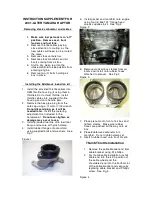
Safety: Active engine hood
Safety
79
Introduction of the New E-Class Coupé, Model Series 207
b
Active engine hood
The active engine hood is installed as standard
equipment in order to reduce the accident loads for
pedestrians and cyclists and to meet the legal
requirements in Europe and Japan.
The system is designed to operate in a vehicle
speed range of 25 - 55 km/h.
In the event of a collision with a pedestrian, the
appropriate pedestrian protection sensor transmits
a signal to the supplemental restraint system
control unit. This actuates the spring-loaded engine
hood lifters in the area of the hood hinges, which
raise the hood by approx. 50 mm. The additional
space gained between the engine hood and compo-
nents in the engine compartment results in an effi-
cient and gentle deceleration when impacted by the
pedestrian's head.
The deformation properties of the hood were devel-
oped specifically to meet these requirements. The
use of aluminum and a homogeneous inner part on
the inside of the engine hood further reduce the
loads during an impact.
The function sequence occurs in the following
stages:
1 During an impact, sensors installed in the
bumper and on the flexural member generate
acceleration signals, which are relayed to the
supplemental restraint system control unit.
2 When it receives the acceleration signals, the
supplemental restraint system control unit
activates the spring-loaded engine hood lifters
at the hinges of the engine hood on each side.
3 This triggers the spring-loaded engine hood
lifters and the hood is raised by a distance of
approx. 50 mm in the area of the hood hinges on
both sides.
P88.40-2860-00
Active engine hood (triggered)
i
Note
Never attempt to press the engine hood back
down at the rear when it has triggered. This can
cause damage to the hood.
– This printout will not be recorded by the update service. Status: 01 / 2009 –
















































